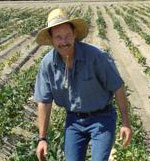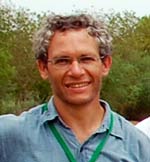Matthew Blair: Principal Investigator, Objective 3
Go back to Legumes
 Educational background
Educational backgroundPh.D. 1998, Cornell University, USA; M. Sc., University of Puerto Rico; B. Sc. Cornell University. Postdoctoral training at Cornell University (Department of Plant Breeding and Institute for Genomic Diversity).
Role in the TLI project
Principal Investigator – Objective 3 for Common Beans. Research on inheritance of drought tolerance through diversity/association mapping, QTL analysis and marker development. Improvement of Andean genotypes through recurrent selection, pedigree selection and advanced backcross breeding.
Scientific interests
Research interests are in tagging traits that are important for common bean production in the tropics and evaluating and using the genetic diversity in common bean and related species for crop improvement. We have developed the first comprehensive set of microsatellite markers for common bean that permits readily usable, site-specific PCR markers for mapping and are developing EST and SNP based genetic markers for map saturation. We have analyzed national and international collections of germplasm for population structure and have begun association mapping with phenotypic data on these collections. We have also used marker technologies to evaluate quantitative trait loci for abiotic and biotic stress tolerance with an emphasis on drought stress and adaptation to low P or high Al soils. We also specialize in developing assays for marker-assisted selection of various important disease pathogens and insect pests of beans.
Professional affiliation
Active member of Bean Improvement Cooperative, Bean Genetics Committee, American Society of Crop Sciences, American Society of Botany.
Publications
The following three papers are highly relavant to the TL1 project
- Blair MW, Díaz JM, Hidalgo R, Díaz LM, Duque MC (2007) Microsatellite characterization of Andean races of common bean (Phaseolus vulgaris L.). Theor Appl Genet 116: 29-43
- Blair MW, Fregene MA, Beebe SE, Ceballos H (2007) Marker Assisted Selection in Common Beans and Cassava. In E. Guimaraes (ed.) Marker-Assisted Selection. Current status and future perspectives in crops, livestock, forestry and fish. FAO. Chp 7: p.81 – 116.
- Blair MW, Giraldo MC, Buendia HF, Tovar E, Duque MC, Beebe SE (2006) Microsatellite marker diversity in common bean (Phaseolus vulgaris L.) Theor Appl Genet 113: 100–109.
Jeffrey D. Ehlers: Principal investigator, Objective 2
Go back to Legumes
 Educational background
Educational background
Ph.D. Genetics, University of California, Davis, 1984; M.S. Vegetable Crops, University of California, Davis, 1980, B.S. Plant Science, University of California, Riverside, 1979.
Role in the TLI project
I currently serve as Principal Investigator of Objective 2 (Improve cowpea productivity for marginal environments in sub-Saharan Africa) of the Generation Challenge Programme project “Improving tropical legume productivity for marginal environments in sub-Saharan Africa” (termed the “Tropical Legumes 1”or TL-I Project). This project focuses on improving the productivity of legume crops of high importance to food security and poverty reduction efforts in sub-Saharan Africa through coupling of modern biotechnologies with applied breeding efforts.
Scientific interests
My research interests are genetic improvement, genetic diversity analysis, and identification of genes for drought tolerance and resistance to insect pests in cowpea. I conduct an applied cowpea breeding program developing improved cowpea varieties for the US, and improved germplasm for countries in Africa. Since 1992, I have been closely involved with the USAID-funded Bean/Cowpea Collaborative Research Support Programme (now called 'Dry Pulse Collaborative Research Support Program') that supports research and training activities in several African and Latin American countries. I maintain a cowpea germplasm collection of 5,000 accessions and provide seeds from this collection to scientists all over the world.
Professional affiliation
Crop Science Society of America, American Society of Agronomy
Publications
- Hall AE, Singh BB, Ehlers JD (1997) Cowpea breeding. In Janick, J. (ed.), Plant Breeding Reviews, Vol. 15. John Wiley & Sons, Inc., New York, pp 215-274.
- Timko MP, Ehlers JD, Roberts PA (2006). Cowpea. In: Kole, C (ed) The Genomes: A Series on Genome Mapping, Molecular Breeding & Genomics, Science Publisher, Inc., Enfield, New Hampshire. In Press
- Fang, J., C.C. T. Chao, P.A. Roberts, and J.D. Ehlers. 2007. Genetic diversity of cowpea [Vigna unguiculata (L.) Walp.] in four West African and USA breeding programs as determined by AFLP analysis. Genet Resour Crop Evol. 54:1197-1209.
Vincent Vadez: Principal Investigator, Objective 1
Go back to Legumes

Educational background
PhD in Plant Physiology – Agronomy Engineer (France)
Role in the TLI project
Principal Investigator of Objective 1 as of June 2008. Activity 4 leader of Objective 1 (groundnut) and have a prominent role in Activity 1 of Objective 1. I’m also closely involved in Activity 1 & 4 of Objective 4 (chickpea).
Scientific interests
My research focuses on plant response to water deficit in mandated crops of ICRISAT, and mostly on groundnut, chickpea, pearl millet and sorghum. My research at ICRISAT focus on traits that are closely related to the yield architecture and that can have a benefit under water limited environments. We focus on transpiration efficiency (TE, i.e. the amount of biomass produced per unit of water transpired) and our goal is to obtain QTL for TE that would then be introgressed into locally adapted germplasm. Challenges related to TE are: (i) explore the genetic diversity for this trait towards the development of suitable mapping populations; (ii) understand the interaction between TE and the environmental conditions; (iii) Assess the potential of introgressing such traits from wild Arachis relative. We focus on water uptake by roots, where our goal is also to obtain QTL for an increased and better patterned water uptake towards yield increase under water limited environments. Our challenges are: (i) to understand the relation between “physical” root traits (depth, length density, volume, etc…) and functional root traits (water uptake, pattern of uptake over time under stress), and their relation to yield; (ii) explore the diversity for these traits; (iii) map QTL for such traits.
Professional affiliation
ICRISAT
- Vadez, V., L. Krishnamurthy, J.W. Kashiwag, J. Kholova, J.M. Devi, K.K. Sharma, P. Bhatnagar-Mathur, D.A. Hoisington, C.T. Hash, F.R. Bidinger and J.D.H. Keatinge. 2007. Exploiting the functionality of root systems for dry, saline, and nutrient deficient environments in a changing climate. Journal of SAT Agricultural Research 4 (Special Symposium Edition) http://www.icrisat.org/journal/specialproject.htm
- Krishnamurthy, L., V. Vadez, M.J. Devi, R. Serraj, S.N. Nigam, M.S. Sheshshayee, S. Chandra, and R. Aruna. 2007. Variation in transpiration efficiency and its related traits in a groundnut (Arachis hypogaea L.) mapping population. Field Crops Research 103:189-197.
- Sinclair, T.R. and V. Vadez. 2002. Physiological traits for crop yield improvement in low N and P environment. Plant and Soil 245(1):1-15.


